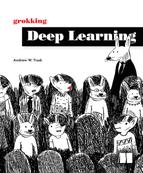About this book
Grokking Deep Learning was written to help give you a foundation in deep learning so that you can master a major deep learning framework. It begins by focusing on the basics of neural networks and then switches its focus to provide an in-depth look at advanced layers and architectures.
Who should read this book
I’ve intentionally written this book with what I believe is the lowest barrier to entry possible. No knowledge of linear algebra, calculus, convex optimization, or even machine learning is assumed. Everything from those subjects that’s necessary to understand deep learning will be explained as we go. If you’ve passed high school mathematics and hacked around in Python, you’re ready for this book.
Roadmap
This book has 16 chapters:
- Chapter 1 focuses on why should you learn deep learning, and what you’ll need to get started.
- Chapter 2 starts to dig deep in fundamental concepts, such as machine learning, parametric and nonparametric models, and supervised and unsupervised learning. It also introduces the “predict, compare, learn” paradigm that will continue through the following chapters.
- Chapter 3 will walk you through using simple networks to make a prediction, as well as provide your first look at a neural network.
- Chapter 4 will teach you how to evaluate the predictions made in chapter 3 and identify errors to help train models in the next step.
- Chapter 5 focuses on the learn part of the “predict, compare, learn” paradigm. Using an in-depth example, this chapter walks through the learning process.
- In chapter 6, you’ll build your first “deep” neural network, code and all.
- Chapter 7 focuses on the 10,000-foot view of neural networks and works to simplify your mental picture.
- Chapter 8 introduces overfitting, dropout, and batch gradient descent, and teaches you how to classify your dataset within the new network you just built.
- Chapter 9 teaches activation functions and how to use them when modeling probabilities.
- Chapter 10 introduces convolutional neural networks, highlighting the usability of structure to counter overfitting.
- Chapter 11 dives into natural language processing (NLP) and provides foundational vocabulary and concepts in the deep learning field.
- Chapter 12 discusses recurrent neural networks, a state-of-the-art approach in nearly every sequence-modeling field, and one of the most popular tools used in the industry.
- Chapter 13 will fast-track you on how to build a deep learning framework from scratch by becoming a power user of deep learning frameworks.
- Chapter 14 uses your recurrent neural network to tackle a more challenging task: language modeling.
- Chapter 15 focuses on privacy in data, introducing basic privacy concepts such as federated learning, homomorphic encryption, and concepts related to differential privacy and secure multiparty computation.
- Chapter 16 will give you the tools and resources you need to continue your deep learning journey.
About the Code conventions and downloads
All code in the book is presented in a fixed-width font like this to separate it from ordinary text. Code annotations accompany some of the listings, highlighting important concepts.
You can download the code for the examples in the book from the publisher’s website at www.manning.com/books/grokking-deep-learning, or from https://github.com/iamtrask/grokking-deep-learning.
Book forum
Purchase of Grokking Deep Learning includes free access to a private web forum run by Manning Publications, where you can make comments about the book, ask technical questions, and receive help from the author and from other users. To access the forum, go to https://forums.manning.com/forums/grokking-deep-learning. You can also learn more about Manning’s forums and the rules of conduct at https://forums.manning.com/forums/about.
Manning’s commitment to our readers is to provide a venue where a meaningful dialogue between individual readers and between readers and the author can take place. It isn’t a commitment to any specific amount of participation on the part of the author, whose contribution to the forum remains voluntary (and unpaid). We suggest you try asking the author some challenging questions lest his interest stray! The forum and the archives of previous discussions will be accessible from the publisher’s website as long as the book is in print.
